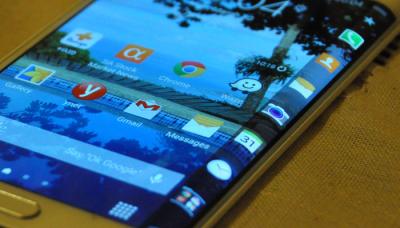Super AMOLED: introduction and market status
OLED displays use organic materials that emit light when electricity is applied. OLEDs enable emissive, bright, thin, flexible and efficient displays. OLEDs are replacing LCDs in most display applications - from smartphones and wearables to monitors and TVs.

Samsung's Super AMOLED displays, announced in 2010, are AMOLED displays for mobile devices (such as smartphones, wearables and tablets) with an integrated touch function. The thickness of the touch sensor is just 0.001 mm and this allows the screen to provide better images and to have great visibility even in direct sunlight compared with regular AMOLED displays with an external touch layer.
Samsung is producing hundreds of millions of Super AMOLED displays today, used mostly in smartphones, but also in other devices. These are considered to be some of the best displays on the market.
Super AMOLED and the Pentile matrix
Samsung's Super AMOLED displays use a Pentile matrix sub-pixel design. That means that the green sub-pixel is shared by two pixels and the display has only 2 sub-pixels per real 'pixel' compared to the classic RGB matrix design (or Real-Stripe). You can see a PenTile matrix vs a Real-Stripe one on the images below (the PenTile is on the right). Newer Super AMOLED displays use a different PenTile matrix (Diamond Pixel pattern).
Super AMOLED vs Dynamic AMOLED
In 2019 Samsung introduced its next-generation mobile display technology, which it calls Dynamic AMOLED. Basically a Dynamic AMOLED is similar to a Super AMOLED display, but it adds HDR support. Samsung's highest end smartphones adopt the company's Dynamic AMOLED 2X LTPO AMOLED displays.
Further reading
- Introduction to OLEDs
- Samsung's OLED displays
- Pentile Technology explained
- Flexible OLEDs
- OLED mobile phones
- The OLED Toolbox: a one-stop-shop for OLED information, insights, analysis and guides
Motorola's Droid RAZR now shipping
Motorola's Droid RAZR is now shipping - starting at $111 (with a Verizon contract). The Droid RAZR is an LTE Android smartphone with a 4.3" qHD (960Ã540) Super AMOLED Advanced display. Other features include Gorilla Glass, a dual-core 1.2Ghz CPU, 8mp camera capable of Full-HD video, 1GB RAM, 16GB of flash memory (and a microSD slot). The RAZR is very thin at 7.1mm.

HTC to use AMOLED in their phones again?
There are reports that HTC is preparing a new Android smartphone - which will come with a 4.3" qHD Super AMOLED display (which seems to be the same one used in Motorola's Droid RAZR). This will be HTC's first OLED phone since they switched back to LCD in June 2010 due to Samsung's AMOLED supply issues. It's great to see HTC back into OLEDs...
The new handset (codename Ville) will sport a new UI (Sense 4.0), a 1.5Ghz dual-core processor and an 8mp camera (1080p video support). HTC will announce the Ville during MWC 2012 and release it in April 2012.
The Samsung Note is available unlocked in the US for $849.99
Amazon.com are now offering the Samsung Note unlocked for $849.99, probably shipped from Europe. The Galaxy Note is a large Android v2.3 phone/mini-tablet with a 5.3" Super AMOLED display with an HD resolution: 1280x800 (a Super AMOLED HD display). Other specs include a dual-core 1.4Ghz processor, 8mp camera, touch display with pen input (it has a stylus). The phone is 9.65mm thick and weights 178 grams.
The Galaxy Note's 5.3" HD Super AMOLED display "is as gorgeous as it is enormous"
Engadget posted a review of Samsung's Galaxy Note, and they say that "the 5.3" HD Super AMOLED display is as gorgeous as it is enormous...1280 x 800 pixels in a smartphone display is quite a feat, and it's just as impressive to behold as it sounds. The Note's 5.3-inch Super AMOLED screen is incredibly bright, vibrant and detailed, thanks to its 285ppi resolution... colors on the Note pop just as they do on the GS II, that eye-pleasing contrast and saturation we've come to love from Samsung's AMOLED displays, and little vibrancy is lost when viewed from the side. However, color accuracy does start to wander a bit. This is indeed a PenTile display and so there are more green sub-pixels than any other color. This gives everything an ever-so slightly sickly tinge, especially when viewed off-angle..."

Samsung's Galaxy Note is a large Android v2.3 phone (or mini-tablet?) with a 5.3" Super AMOLED display with an HD resolution: 1280x800. Other specs include a dual-core 1.4Ghz processor, 8mp camera, touch display with pen input (it has a stylus). The phone is 9.65mm thick and weights 178 grams. The note is now shipping in Europe (£592 in the UK, without a contract).
AUO launches a 4.3" 257 ppi AMOLED panel, shows 6" transparent OLEDs
 AUO unveiled a new 4.3" AMOLED panel offering 257ppi. The company actually said they "launched" the new product, but it seems that they aren't mass producing it yet (this will probably happen in early 2012). But the company is reportedly shipping samples already.
AUO unveiled a new 4.3" AMOLED panel offering 257ppi. The company actually said they "launched" the new product, but it seems that they aren't mass producing it yet (this will probably happen in early 2012). But the company is reportedly shipping samples already.
The company has also demonstrated a 6" transparent OLED display (with a transparency rate of over 35%), and a 4" Touch AMOLED display that features 30% less energy consumption compared to other AMOLED. We assume that this display includes an in-cell touch panel - similar to Samsung's Super AMOLED displays. AUO unveiled their AMOLED in-cell touch technology back in June 2010.
Samsung announced two new Windows Phone 7.5 phones with Super-AMOLED displays
Samsung announced two new phones, both of which will use Microsoft's Windows Phone 7.5 (Mango) OS. Both of the will be launched soon by AT&T. The high-end Focus S has a 4.3" Super AMOLED Plus display, a 1.4Ghz processor, 4G-capable speed and a 8mp camera. The phone is 8.55mm thick.
 Samsung Omnia W
Samsung Omnia W
The Focus Flash has a small 3.7" Super AMOLED display, the same processor and a 5mp camera. This same phone will be called Omnia W for other non-US networks.
Samsung's Galaxy Tab 7.7 Tablet and Note smartphone hands on
Following yesterday's exciting launch of the 5.3" HD Super AMOLED Galaxy Note phone and the Galaxy Tab 7.7 Super AMOLED tablet, here are a couple of hands on videos showing these two devices:
Samsung launches the 7.7" Super AMOLED tablet and the 5.3" HD Super AMOLED phone
Samsung launched three OLED products today, two of which are very exciting. The first is the Galaxy Tab 7.7, which has the world's largest mass-production OLED display at 7.7" (1280x800). It's a Super AMOLED Plus display. Other include Android v3.2, Dual-core 1.4Ghz processor, HSPA+ radio, 16GB to 64GB internal storage and a microSD slot, Wi-Fi, GPS and two cameras (3MP and 2MP).

The second exciting product is the Galaxy Note, a 5.3" Super AMOLED phone, offering the same resolution as the Tab - 1280x800. Samsung is using PenTile here. They are not using the Super AMOLED HD brand we thought they'd use, istead they simply call it a HD Super AMOLED display. It seems that Samsung will use Super AMOLED for PenTile displays and Super AMOLED Plus for non-pentile display, regardless of pixel density.
Super AMOLED HD is real, Samsung developed an improved process and uses new materials
I just had an interesting talk with two industry insiders (one of them is a Samsung supplier) - about Samsung's upcoming Super AMOLED HD display. It turns out that these displays are indeed real - and will be unveiled soon. We can expect 5" to 6" smartphones in fall 2011 (the first will probably be the GT-I9220 with a 5.3" display) and 7" tablets by the end of 2011.
 A 7-inch Super AMOLED prototype
A 7-inch Super AMOLED prototype
According to my sources, Samsung managed to achieve HD resolution on these small displays by using PenTile matrix again (like in the original Super AMOLED displays). They have also developed a new manufacturing process and are using new materials. It might be that they have finally started to use Universal Display's green PHOLED (we reported that Samsung is using a green phosphorescent in their new 5.5-Gen plant, but perhaps they will only start using it in the HD displays).
Samsung phone roadmap leaked, a 5.3" Super-AMOLED Plus phone coming?
 Samsung's phone roadmap was leaked - showing us 9 upcoming phones and two tablets. There are two AMOLED phones in there. The first is the GT-I9220-W43 which features a 5.3" 1280x720 Super-AMOLED-Plus display (or Super-AMOLED-HD?). This might be the Galaxy-Q phone we heard about a few weeks ago. Achieving 720p resolution on a 5.3" display requires around 270 ppi - which isn't possible with Samsung's current AMOLED technology, so we'll label this rumor 'unlikely'?
Samsung's phone roadmap was leaked - showing us 9 upcoming phones and two tablets. There are two AMOLED phones in there. The first is the GT-I9220-W43 which features a 5.3" 1280x720 Super-AMOLED-Plus display (or Super-AMOLED-HD?). This might be the Galaxy-Q phone we heard about a few weeks ago. Achieving 720p resolution on a 5.3" display requires around 270 ppi - which isn't possible with Samsung's current AMOLED technology, so we'll label this rumor 'unlikely'?
The second AMOLED phone is a Bada hone - the Wave III (S8600-W47). It will have a 4" Super AMOLED display.
Pagination
- Previous page
- Page 16
- Next page



